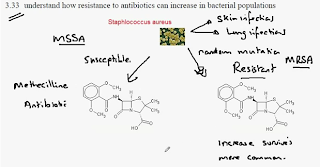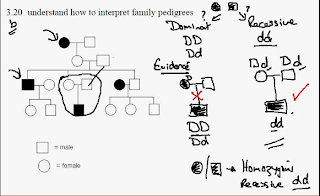- in the urinary system, there are two kidneys
- from each kidney there is a tube that leads to the bladder called the ureter
- this carries urine from the kidney to the bladder
- the urine travels through the bladder down the urathra
Monday, October 31, 2011
2.68b - osmoregulation
- osmoregulation - to control osmosis
- the cells in the body are surrounded by tissue - this is isotonic and means the same amount of fluid is passing through all cells and are maintaining their shape
- if the blood going into the tissue is highly concentrated then its hypertonic or vey dilute hypotonic tissue fluid
- this would cause either too much or too little fluid going into the tissue
- we want to keep it isotonic
- the kidneys controls the composition of the blood
- the kidneys remove excess water and salts, these are then excreted so it does not get into our blood stream
- the cells in the body are surrounded by tissue - this is isotonic and means the same amount of fluid is passing through all cells and are maintaining their shape
- if the blood going into the tissue is highly concentrated then its hypertonic or vey dilute hypotonic tissue fluid
- this would cause either too much or too little fluid going into the tissue
- we want to keep it isotonic
- the kidneys controls the composition of the blood
- the kidneys remove excess water and salts, these are then excreted so it does not get into our blood stream
2.68a - excretion
- urea (nitrogen) come from amino acids, urea is toxic to us in excess - the role of the kidney is to get rid of it
- blood circulates to the liver, its then broken down into the molecule urea
- it re-enters into the blood stream and goes into the kidneys, these will then filter the urea form the blood
- water then goes into the urea to form urine, this drains down the ureters and goes into the bladder
- blood circulates to the liver, its then broken down into the molecule urea
- it re-enters into the blood stream and goes into the kidneys, these will then filter the urea form the blood
- water then goes into the urea to form urine, this drains down the ureters and goes into the bladder
2.67b - human organs of excretion
- in humans, the lungs, kidneys and skin are organs of excretion
- the waste that lungs excrete is carbon dioxide
- the kidneys excrete excess water, urea (from amino acids) and salts
- skin excretes water and salts (sweat) and some urea
- the waste that lungs excrete is carbon dioxide
- the kidneys excrete excess water, urea (from amino acids) and salts
- skin excretes water and salts (sweat) and some urea
2.67a - excrection in plants
- when photosynthesis occurs it gives off carbon dioxide and oxygen as waste products
- respiration is also a form of excretion in plants, and it gives off carbon dioxide and water
- respiration is also a form of excretion in plants, and it gives off carbon dioxide and water
Sunday, October 9, 2011
3.34 - causes of mutation
- mutations can be increased by ionising radiation like sunlight, x-rays or gamma rays
- they can also be increased chemically like tars in tobacco, this causes mutations to the base sequence which can result in cancers
- they can also be increased chemically like tars in tobacco, this causes mutations to the base sequence which can result in cancers
3.32 - types of mutation
- new alleles which cause mutation can be beneficial, harmful or neutral
- beneficial alleles can improve the effect of an enzyme
- a harmful one would be a non-functional enzyme
- a neutral mutation may have no effect at all, or for years but then develop into a beneficial or harmful one due to environmental change
- beneficial alleles can improve the effect of an enzyme
- a harmful one would be a non-functional enzyme
- a neutral mutation may have no effect at all, or for years but then develop into a beneficial or harmful one due to environmental change
3.31 - evolution
- evolution is natural selection
- evolution: change form of organisms or change in frequency of alleles
- natural selection: mechanism of evolution, discovered by charles darwin
- for example, staphloccus aurus which is a lung and skin infection was susceptible to being killed by methecilline, this was called MSSA
- from random mutation one form could break down the methecilline and this was the resistant form called MRSA
- MRSA increases because the MSSA was being killed of because it was susceptible but the MRSA was resistant
- this is natural selection
- evolution: change form of organisms or change in frequency of alleles
- natural selection: mechanism of evolution, discovered by charles darwin
- for example, staphloccus aurus which is a lung and skin infection was susceptible to being killed by methecilline, this was called MSSA
- from random mutation one form could break down the methecilline and this was the resistant form called MRSA
- MRSA increases because the MSSA was being killed of because it was susceptible but the MRSA was resistant
- this is natural selection
3.30 - mutation
- mutation is rare in genetic material but can be inherited
- a change in the base sequence can result in a entirely different protein
- a change in the base sequence can result in a entirely different protein
3.29 - species variation
- variation = differences in phenotype
- variations of phenotype means they have different genotypes and live in a different environment
- there are different types of variation populations
1) all due to a variation genotype i.e. blood type
2) due to genotype and environment i.e. humans
3) environmental variation (no genotype) i.e. language
- variations of phenotype means they have different genotypes and live in a different environment
- there are different types of variation populations
1) all due to a variation genotype i.e. blood type
2) due to genotype and environment i.e. humans
3) environmental variation (no genotype) i.e. language
Sunday, October 2, 2011
Subscribe to:
Posts (Atom)








